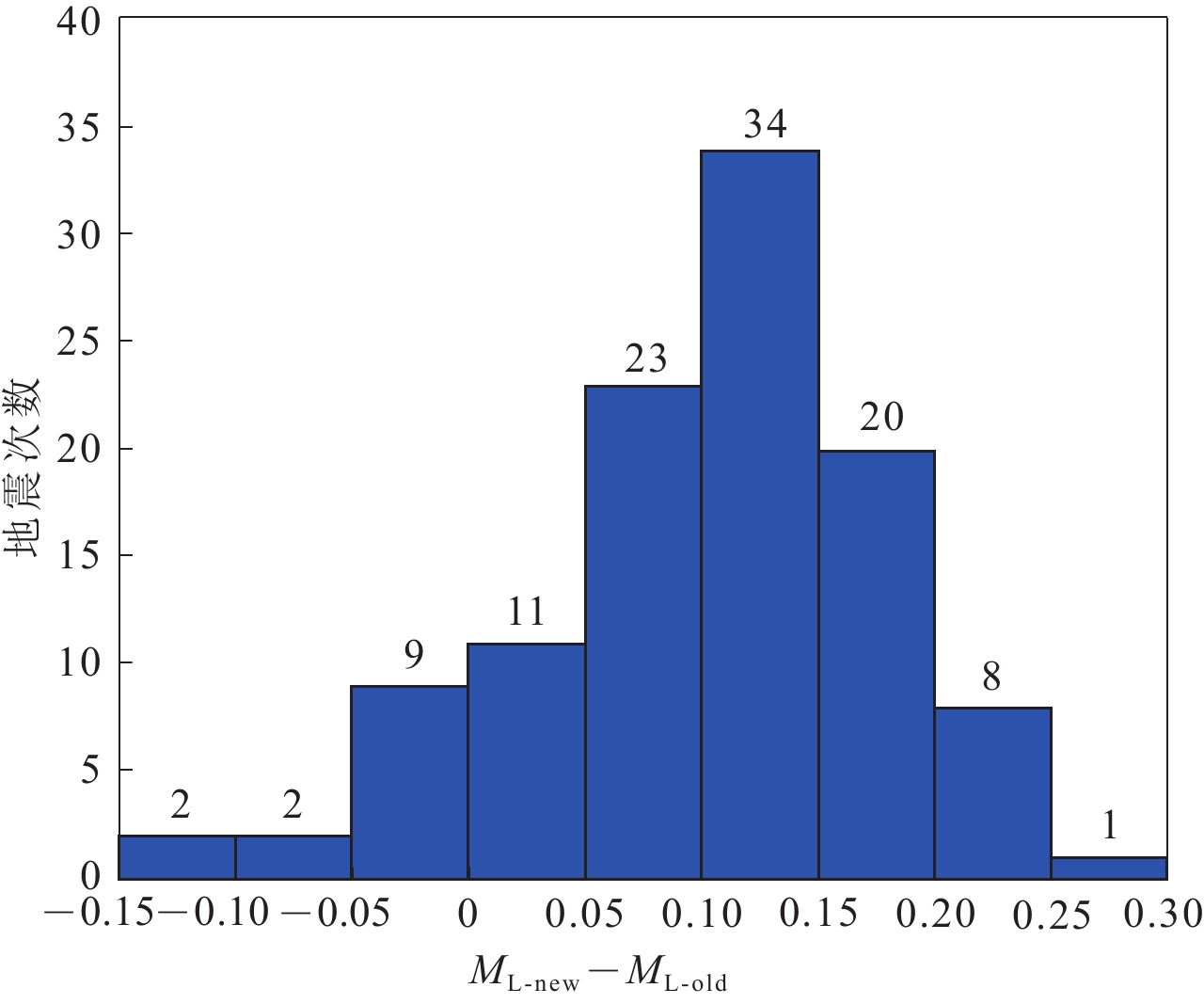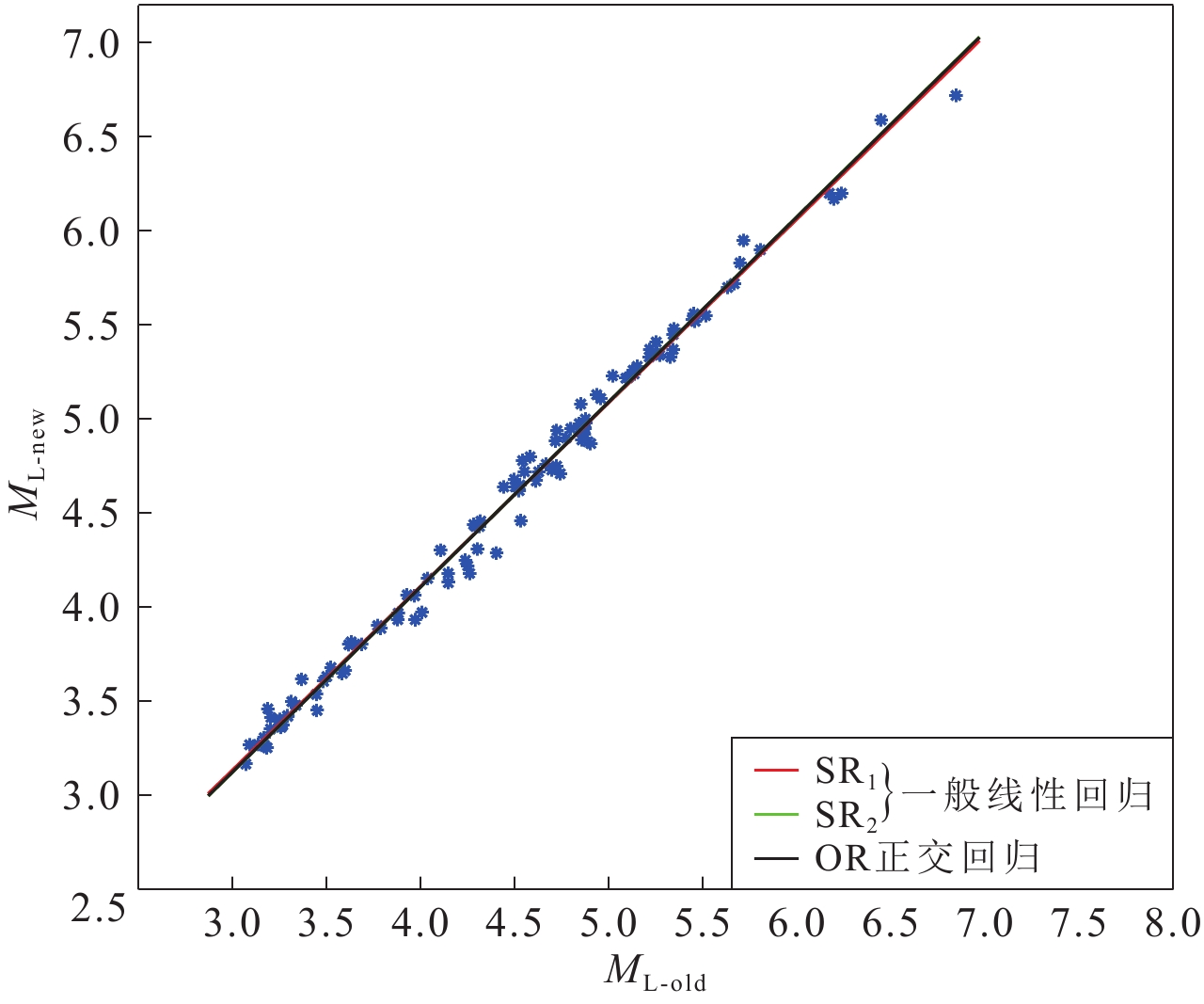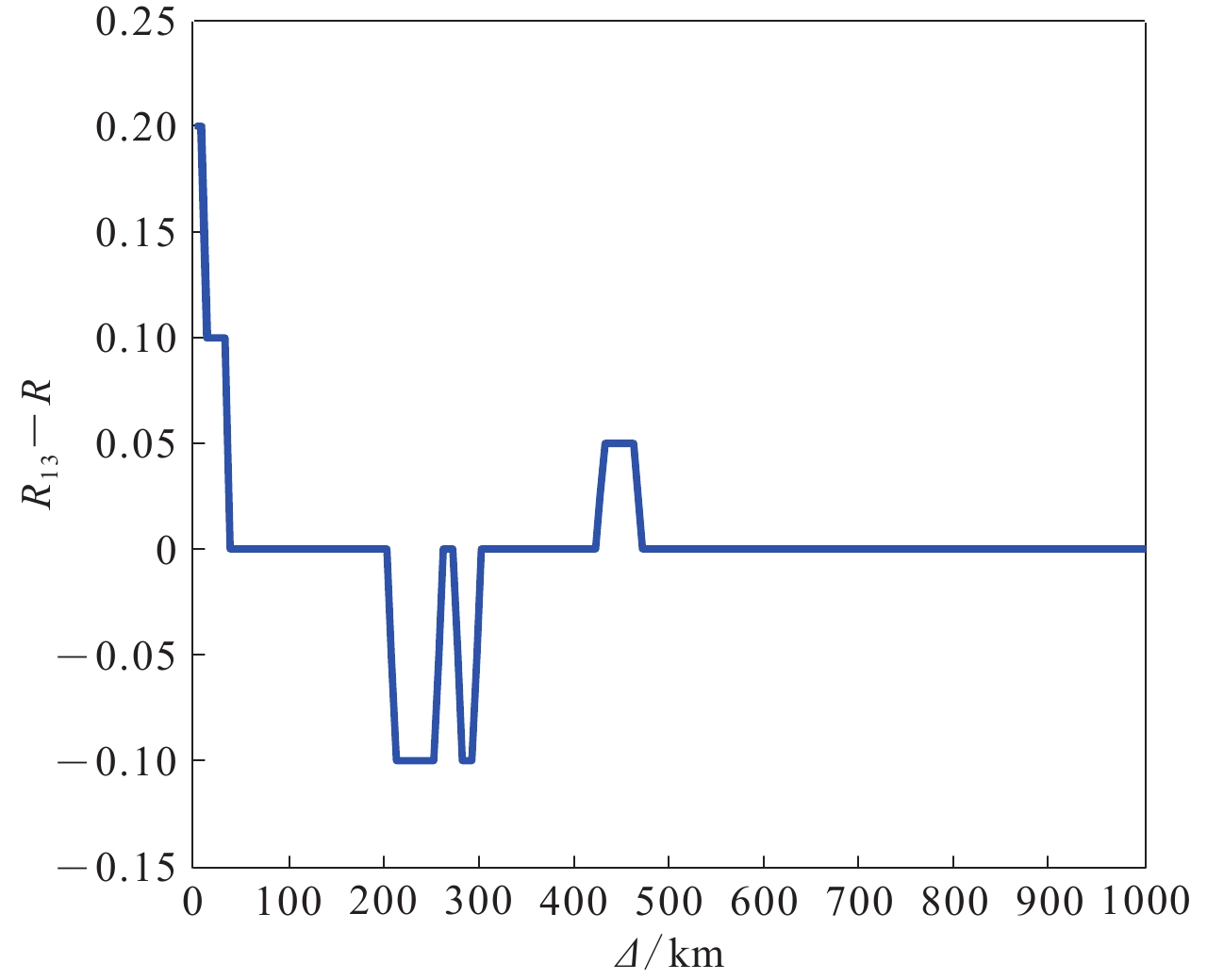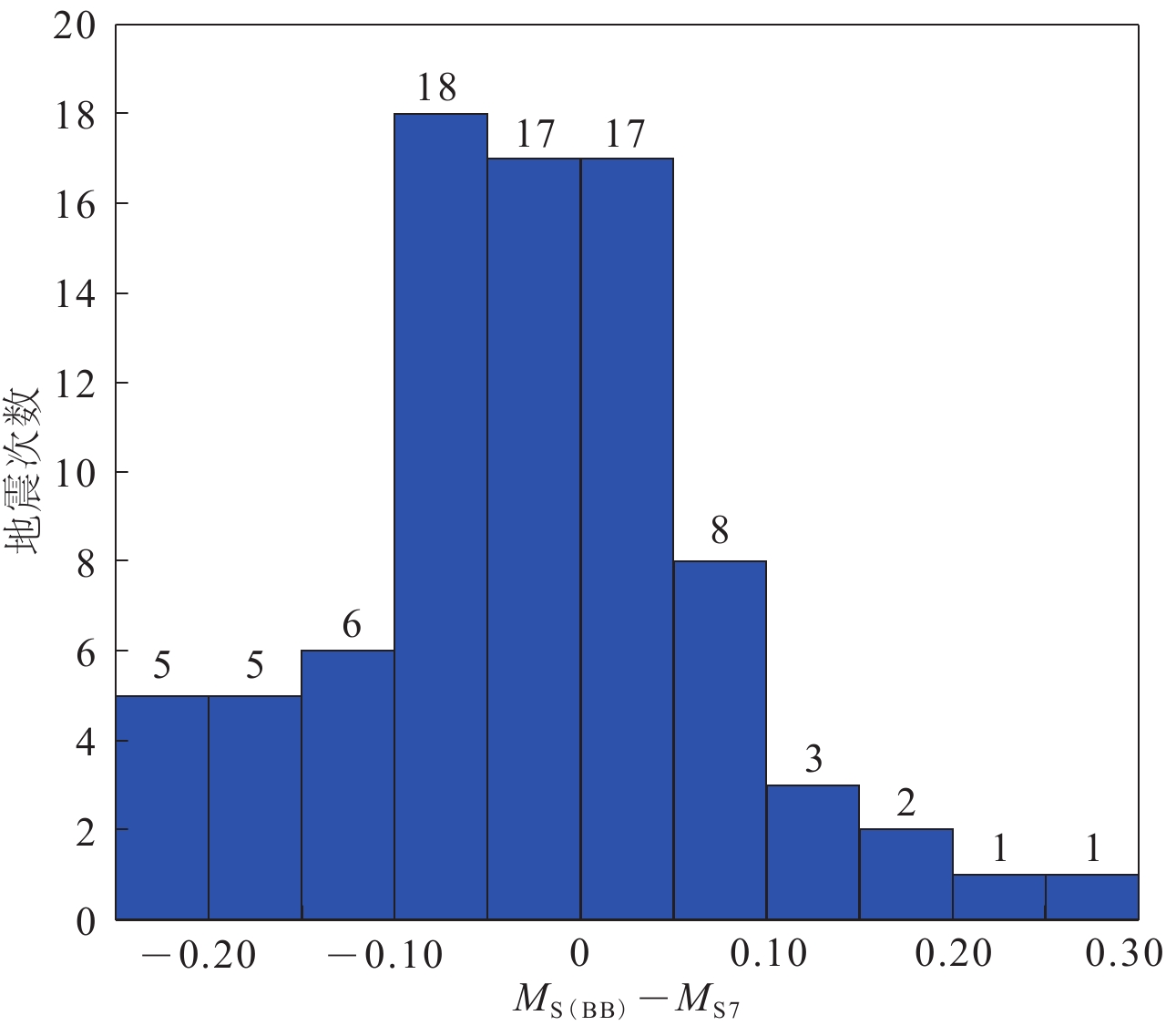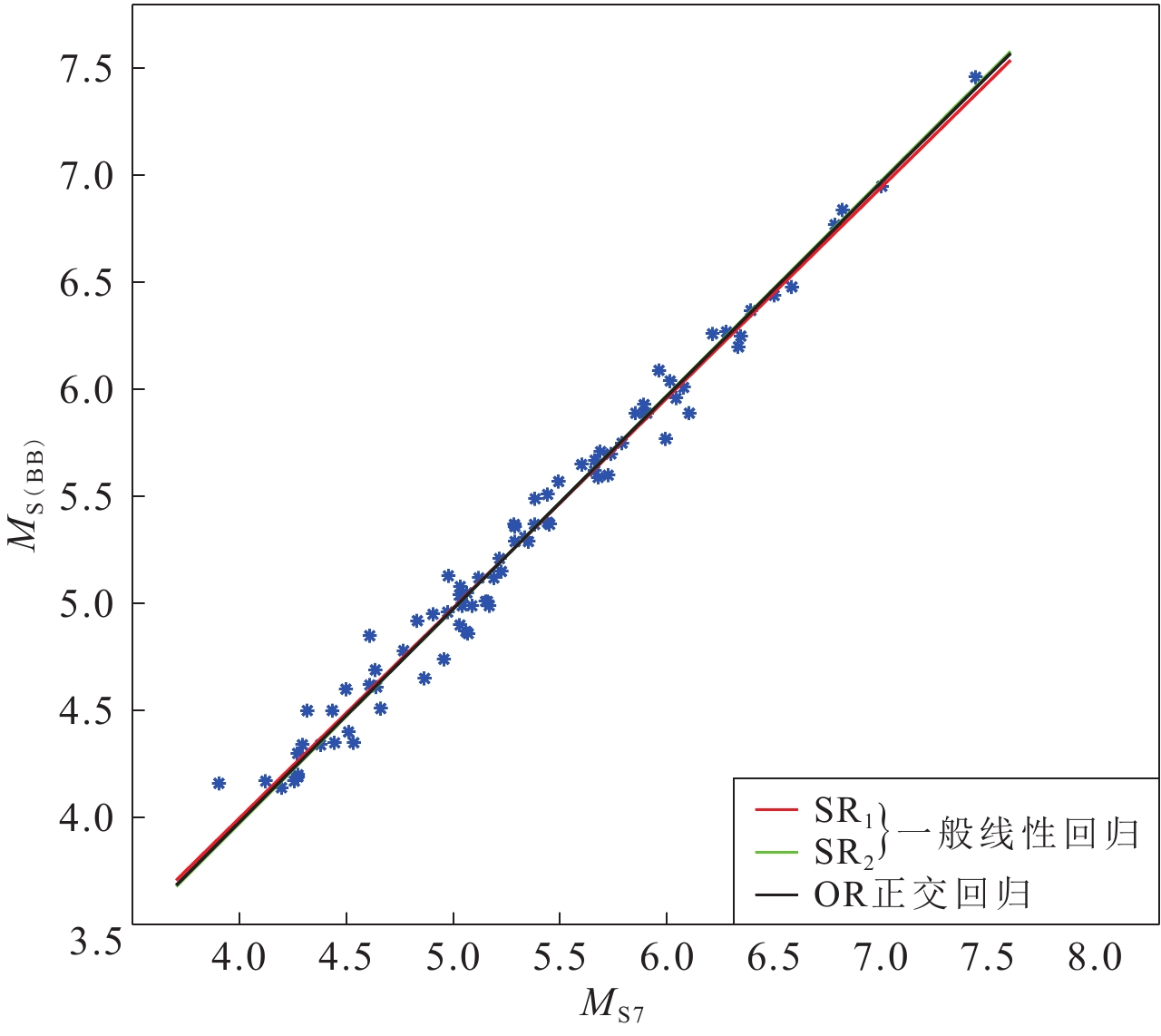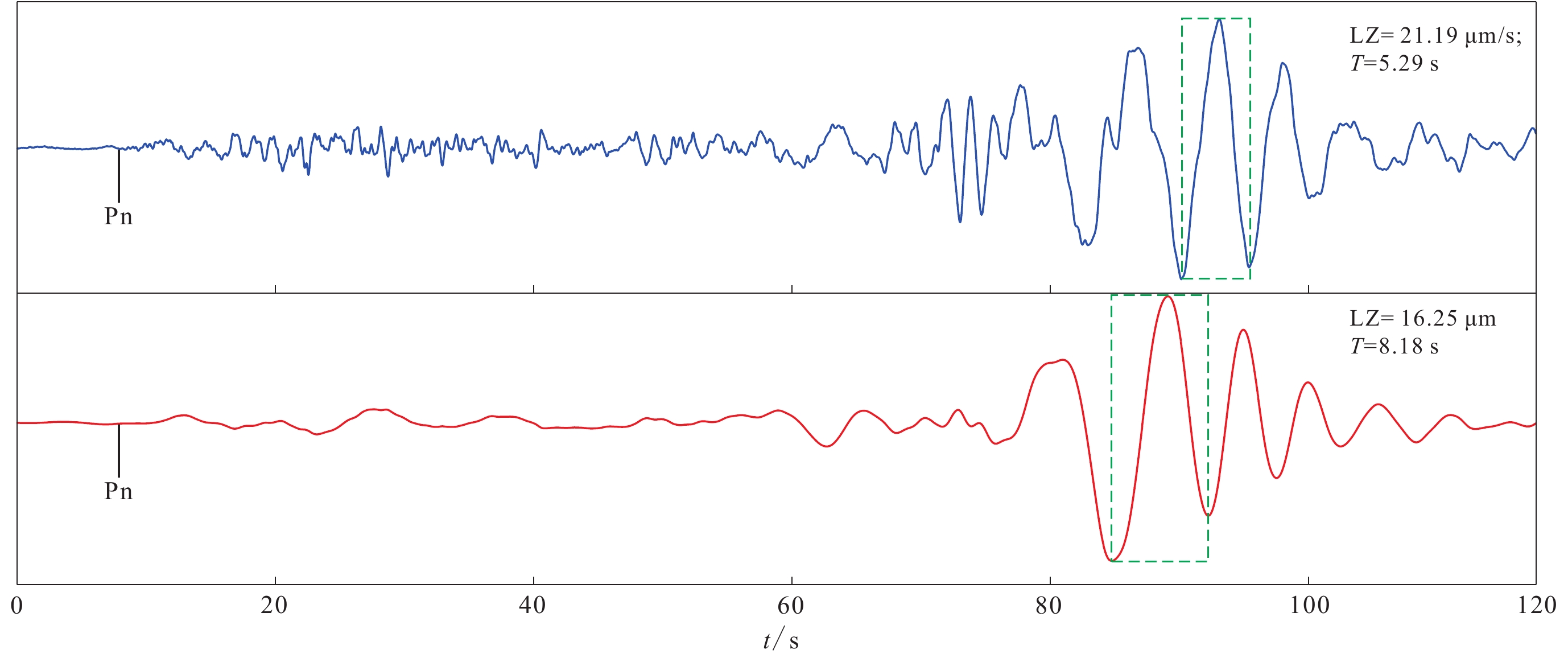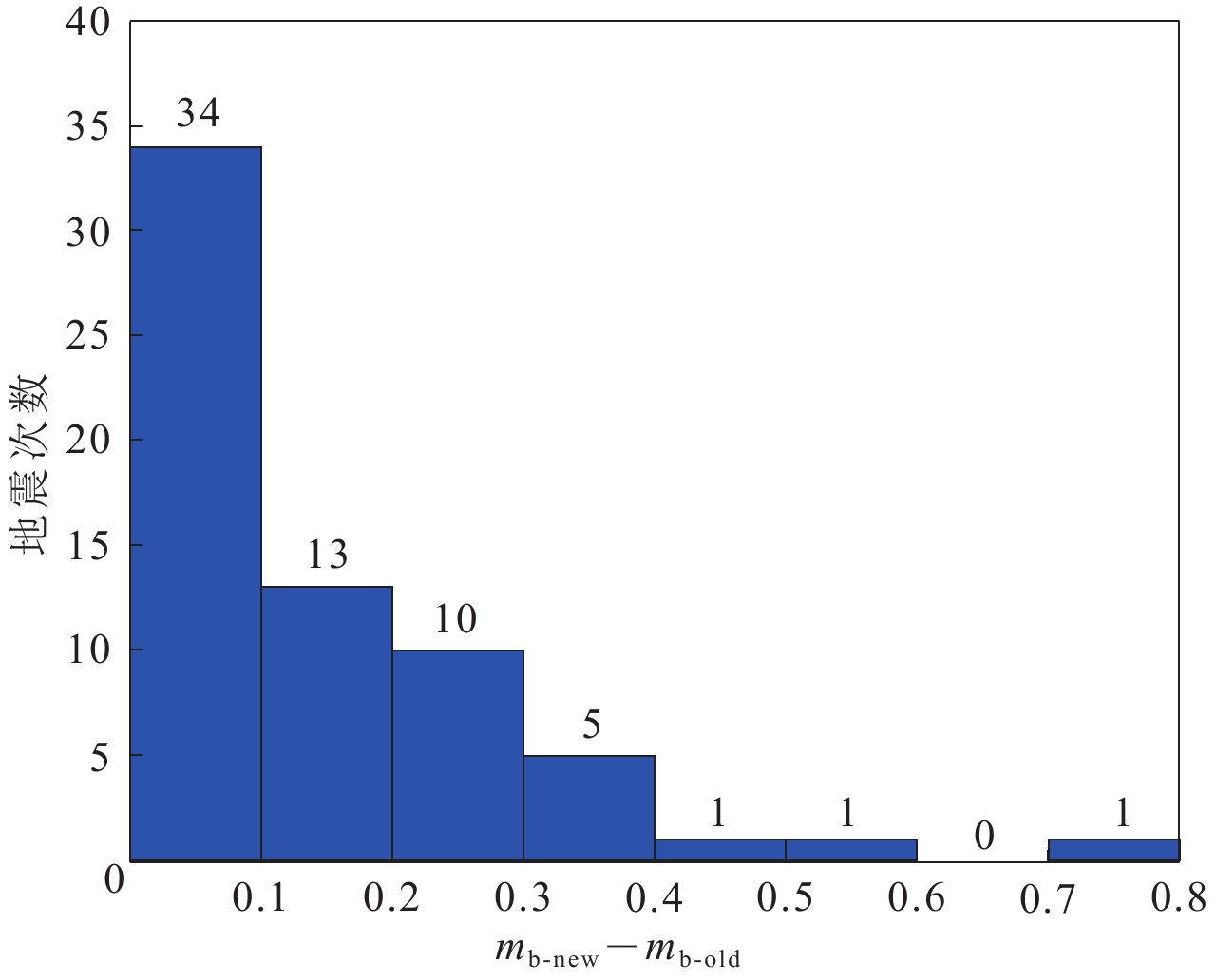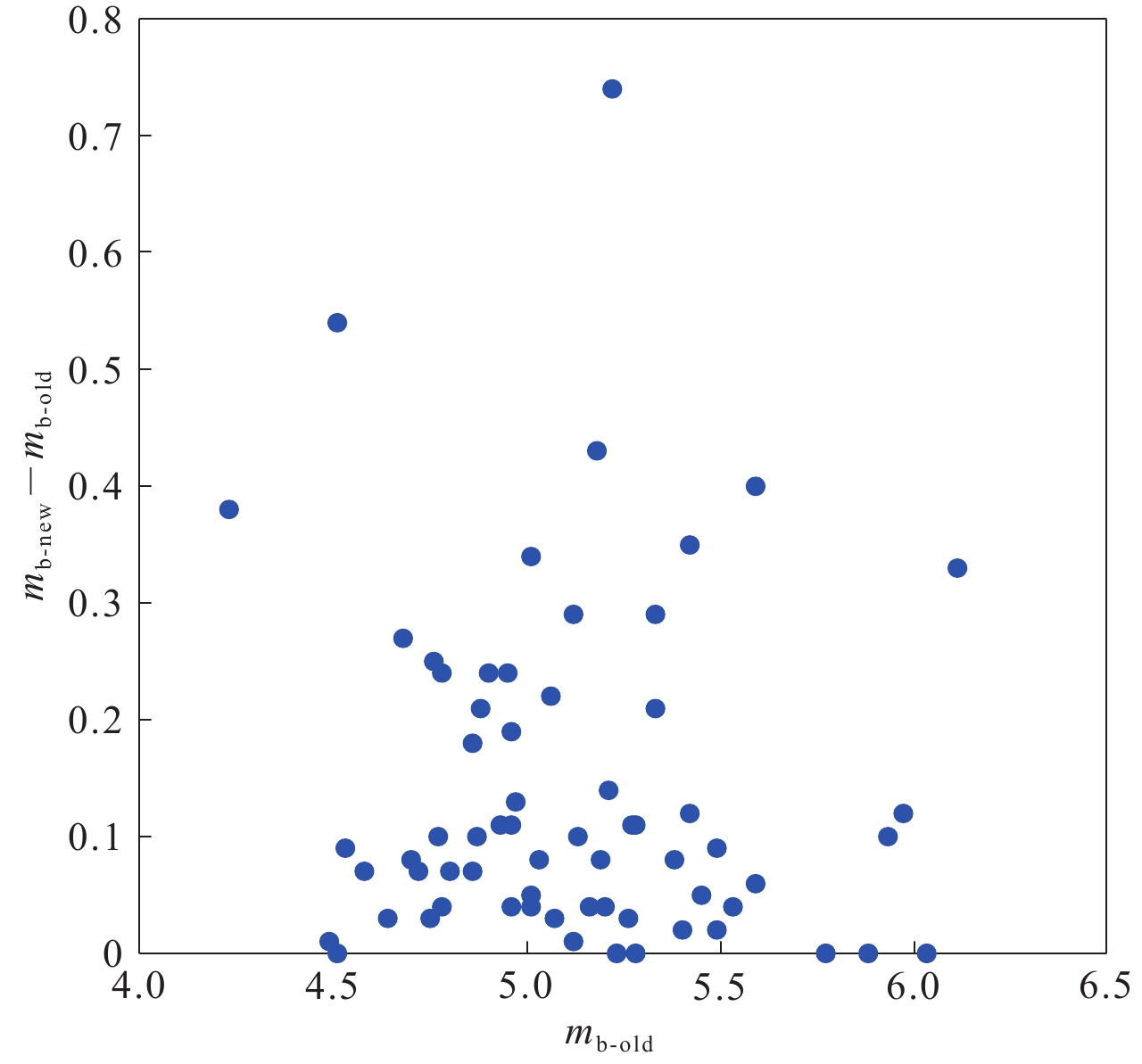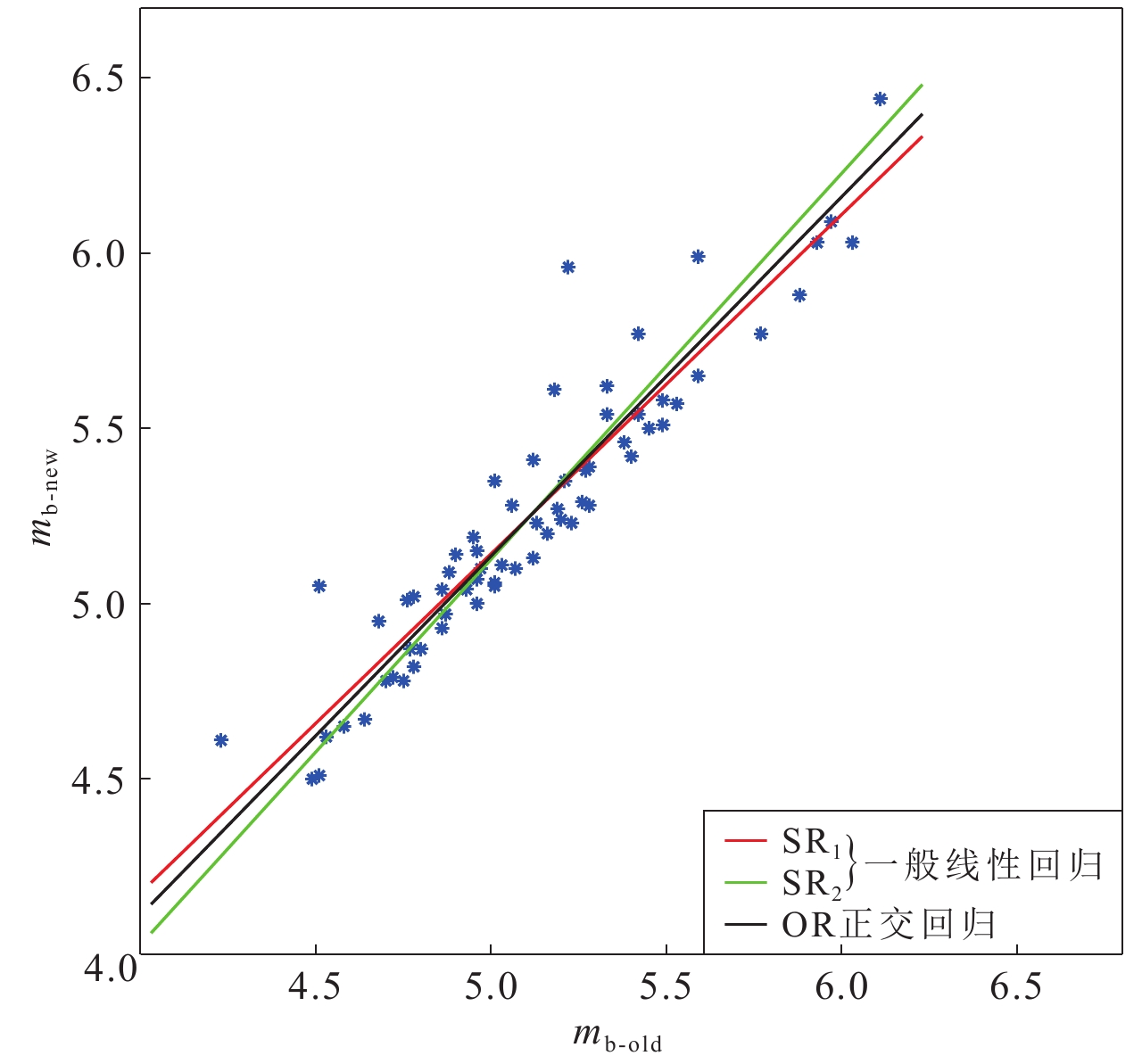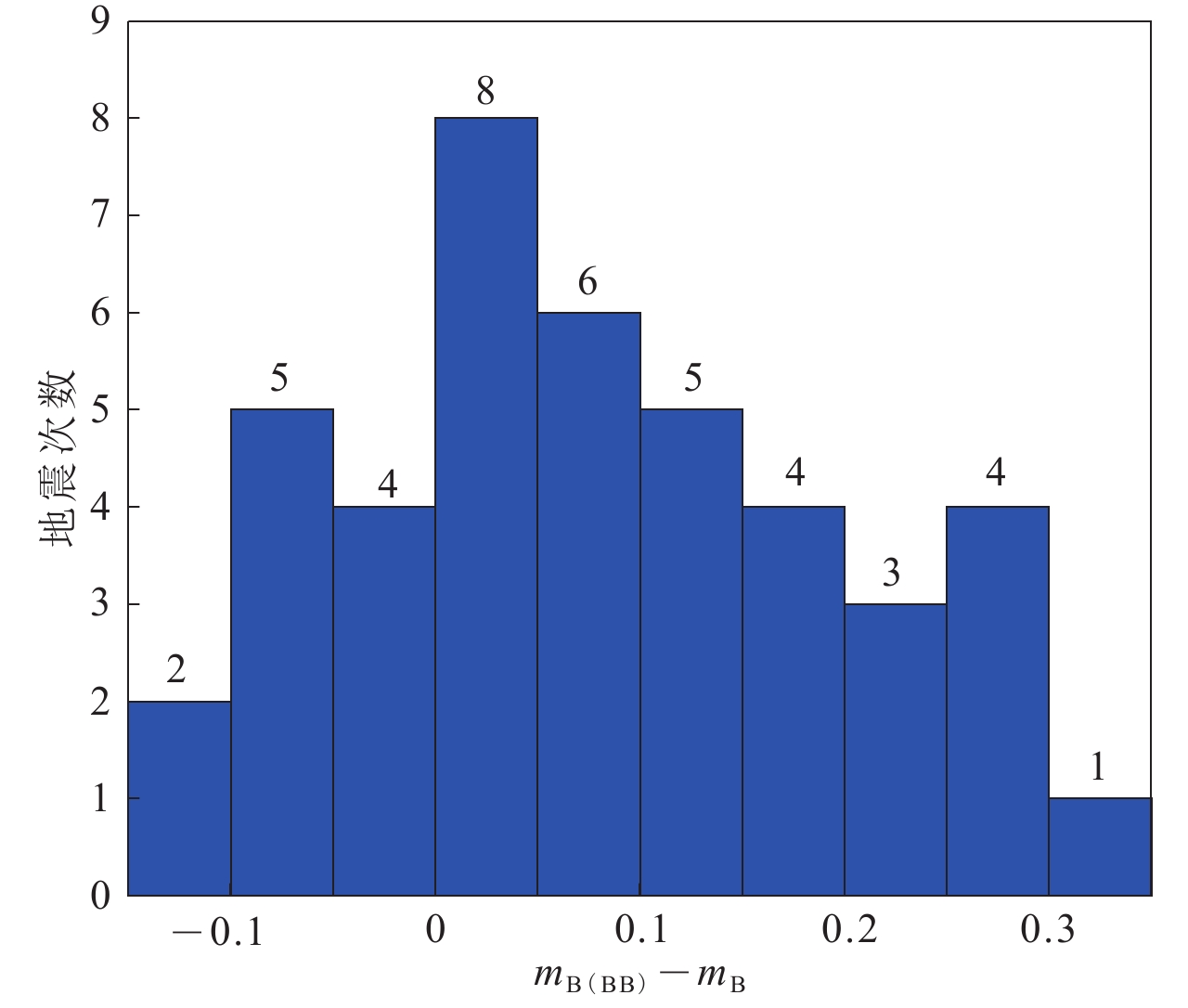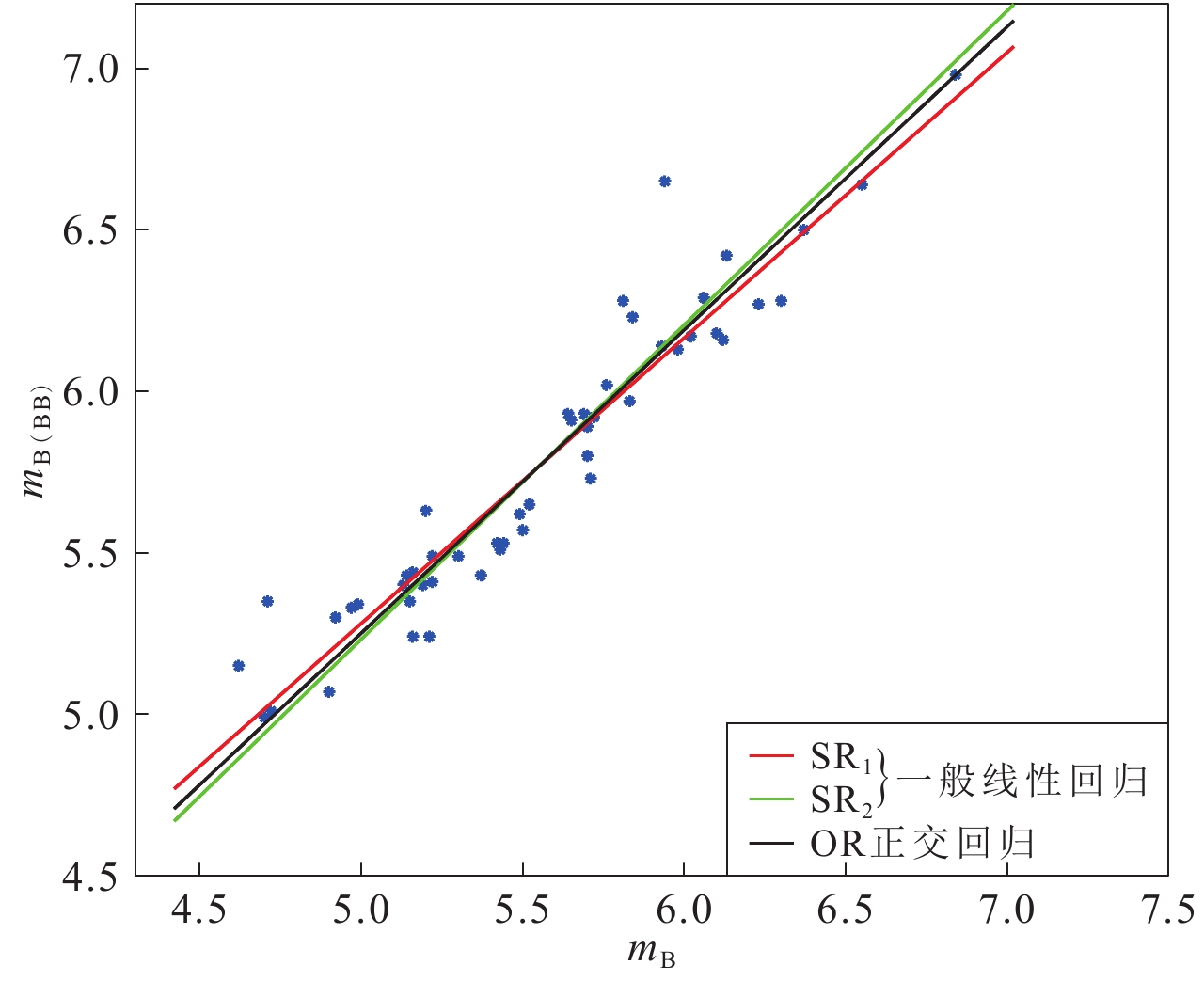Comparison of the new national standard magnitude scales with the traditional magnitude scales
-
摘要: 使用四川省地震台网2013年4月以来的宽频带数字地震资料,对新国家标准震级标度与传统震级标度中的4类震级进行了对比分析。结果表明:新ML与传统ML、MS(BB)与MS7之间的差别最小,相关性最高;所有事件的新mb均大于或等于传统mb;大部分事件的新ML大于传统ML;mB(BB)大于mB的事件多于mB(BB)小于mB的事件;MS(BB)小于MS7的事件数量与MS(BB)大于MS7的事件接近;新ML较传统ML更符合区域地质实际状况,新mb较传统mb更便于测量,MS(BB)较MS7、mB(BB)较mB更适应当前的宽频带数字地震资料,其测定结果更稳定。新国家标准震级标度充分考虑了我国震级测定的历史连续性,很好地继承和衔接了传统震级标度,在可操作性和资料适用性方面有极大提高。Abstract: The new national standard magnitude scales and traditional magnitude scales are analyzed by using broadband seismic data from Sichuan seismic network science April of 2013. The results suggest that the differences between the new and the traditional ML, and the MS(BB) and MS7 are small, hence, they are the high correlated. The new mb is greater than or equal to the traditional mb for all events, while the new ML is greater than the traditional ML for most events. In addition, the MS(BB) is less than the MS7 for half of the events. Moreover, the new ML is more suitable in the actual regional geological condition compared with the traditional one, the new mb is easier to measure, the MS(BB) and mB(BB) are more stable and adapt to the current broadband digital seismic data. Therefore, the new national standard magnitude scale not only has a good continuity of magnitude determination, but also has been greatly improved in terms of operability and applicability.
-
Keywords:
- national standard /
- magnitude scale /
- broadband record /
- magnitude deviation /
- cali-bration function
-
根据美国地质调查局(United States Geological Survey,缩写为USGS)国家地震信息中心(National Earthquake Information Centre,缩写为NEIC)的测定,2020年6月23日15时29分04秒(UTC),墨西哥南部瓦哈卡州发生了一次矩震级MW7.4的地震,NEIC初步确定的震中(preliminary determination epicenter, 缩写为PDE)位于(15.916 3°N,95.953 3°W),震源深度为20 km。美国地质调查局(USGS,2020)和全球矩心矩张量组(GCMT,2020)随后发布了这次地震的矩心矩张量解(表1)。根据USGS (2020)发布的地震目录,在该主震发生后的48小时内发生了9次较大余震,其中最大余震震级达到MW5.4,5次事件深达35 km。
表 1 不同机构所得墨西哥MW7.4地震矩心矩张量解的比较Table 1. Comparison of the centroid moment tensor solutions for the MW7.4 Mexico earthquake obtained by different institutions机构 矩张量/(1020 N·m) 矩心参数 Mrr Mtt Mpp Mrt Mrp Mtp τc/s 北纬/° 西经/° 矩心深度/km GCMT (2020) 0.729 −0.737 0.008 1.220 −0.712 0.200 7.0 16.04 96.06 20 USGS (2020)(W震相) 0.731 −0.752 0.020 1.104 −0.479 0.168 13.2 15.93 95.90 21.5 USGS (2020)(体波反演) 0.527 −0.544 0.017 0.504 −0.289 0.101 − 16.04 95.90 32 本文 0.700 −0.789 0.089 0.825 −0.491 0.218 8.0 15.96 95.89 22 类似于上述两个组织的工作(Dziewonski et al,1981;Kanamori,Rivera,2008;Duputel et al,2012;Ekström et al,2012),我们收集了震中距处于32.5°—88.9°范围内全球地震台网(Global Seismograph Network,缩写为GSN)和数字地震台网联盟(International Federation of Digital Seismograph Networks,缩写为FDSN)的42个台站的长周期垂直分量数据,基于AK135模型计算格林函数(Wang,1999),利用我们自主研发的反演软件(张喆,许力生,2020),通过反演0.01—0.05 Hz频带内的P波波形得到了这次地震的矩心矩张量解。根据反演结果(图1),矩心时间为8 s,矩心震中位于(15.96°N,95.89°W),矩心深度为22 km,标量地震矩为1.24×1024 N·m,相当于MW7.4。基于矩心矩张量解(表1,图2),我们也求得了相应的最佳双力偶解(图2,表2),最佳双力偶成分占97%。最后,我们利用反演结果计算了合成波形,并与观测波形进行了比较,结果如图3所示,可见二者之间的相关系数平均值达到0.93,大多数台站的相关系数在0.90以上,均方根误差达1.33×10−5 m。
![]() 图 1 矩心矩张量反演过程(a) 矩心时间搜索;(b) 矩心搜索;(c) 矩心深度搜索;(d) PDE位置(灰色)和矩心位置(红色)反演得到的矩张量解Figure 1. Inversion process of the centroid moment tensor(a) Search for the centroid time;(b) Search for the centroid;(c) Search for the centroid depth; (d) The moment tensor solutions at the PDE (gray) and centroid (red) locations表 2 不同机构所得墨西哥MW7.4地震的最佳双偶解Table 2. The best double-couple solutions for the MW7.4 Mexico earthquake obtained by different institutes
图 1 矩心矩张量反演过程(a) 矩心时间搜索;(b) 矩心搜索;(c) 矩心深度搜索;(d) PDE位置(灰色)和矩心位置(红色)反演得到的矩张量解Figure 1. Inversion process of the centroid moment tensor(a) Search for the centroid time;(b) Search for the centroid;(c) Search for the centroid depth; (d) The moment tensor solutions at the PDE (gray) and centroid (red) locations表 2 不同机构所得墨西哥MW7.4地震的最佳双偶解Table 2. The best double-couple solutions for the MW7.4 Mexico earthquake obtained by different institutes机构 标量地震矩
/(1020 N·m)双力偶成分
占比节面Ⅰ 节面Ⅱ 走向/° 倾角/° 滑动角/° 走向/° 倾角/° 滑动角/° GCMT (2020) 1.600 100% 270 16 62 118 76 97 USGS (2020)(W震相) 1.423 96% 271 17 70 112 74 96 USGS (2020)(体波) 0.797 99% 266 24 63 114 69 101 本文 1.236 97% 266 22 60 118 71 101 与USGS和GCMT的结果相比(图4),我们反演所得矩心位置(15.96°N,95.89°W,深度22 km)、矩心时间、最佳双力偶解均与其非常相近。根据最佳双力解的节面参数、矩心位置、余震分布以及地震所处的构造环境,我们判断走向266°、倾角22°、滑动角60°的节面为真实的发震断层面(图4)。这是一次以逆冲为主、具有相当走滑分量的断层错动,或者说这是一次发生在俯冲带的斜滑事件。
![]() 图 4 主震震源机制解与余震分布不同颜色的沙滩球和正方形代表不同机构确定的震源机制解及其矩心位置,小圆圈表示余震(来自USGS地震目录),大圆圈表示主震的PDE位置,圆圈和正方形的填充色显示了震源深度Figure 4. The focal mechanism solutions of the mainshock and the aftershock distributionColored beach-balls and squares represent the focal mechanism solutions and centroid locations determined by the various institutions,the small circles refer to the aftershocks (from the USGS catalog),and the large circle indicates the PED locations of the mainshock. The colors filled in the circles and squares indicate the focal depths
图 4 主震震源机制解与余震分布不同颜色的沙滩球和正方形代表不同机构确定的震源机制解及其矩心位置,小圆圈表示余震(来自USGS地震目录),大圆圈表示主震的PDE位置,圆圈和正方形的填充色显示了震源深度Figure 4. The focal mechanism solutions of the mainshock and the aftershock distributionColored beach-balls and squares represent the focal mechanism solutions and centroid locations determined by the various institutions,the small circles refer to the aftershocks (from the USGS catalog),and the large circle indicates the PED locations of the mainshock. The colors filled in the circles and squares indicate the focal depths本研究使用的数字波形数据均通过地震学联合研究会(Incorporated Research Institutions for Seismology,缩写为IRIS)数据中心获取,震源机制数据分别来自全球矩心矩张量(GCMT)和美国地质调查局(USGS),余震数据来自于美国地质调查局(USGS),作者在此表示感谢!
-
表 1 新国家标准震级标度与传统震级标度的比较
Table 1 Comparison of the new standard magnitude scales and the traditional ones
震级类型 传统震级标度 新国家标准震级标度 区别 地方性震级 ML ML 量规函数、仿真模式不同 面波震级 MS,MS7 MS,MS(BB) 取消MS7,增加MS(BB) 体波震级 mb,mB mb,mB(BB) 取消mB,增加mB(BB),且mb测定方法不同 矩震级 MW 增加MW 表 2 ML-new与ML-old相关性及拟合关系
Table 2 Correlation and fitting relations between the new and the traditional ML
事件数量 ML-old 相关系数 回归方法 关系式 均方根 110 (3.0,6.9) 0.996 SR1 ML-new←0.976ML-old+0.208 0.076 SR2 ML-old←1.016ML-new−0.176 0.076 OR ML-new=0.983ML-old+0.178 0.054 注:表中SR1和SR2表示一般线性回归,OR表示正交回归,具体详见刘瑞丰等(2007)。 表 3 MS(BB)与MS7的差异
Table 3 Differences between the magnitude MS (BB)and theMS7
震级 计算公式 振幅测量 仿真类型 适用范围 量规函数 记录类型 取值 震中距/° 地震波周期/s MS(BB) MS(BB)=lg(Vmax/2π)+
1.66lgΔ+3.3速度记录 质点运动速度
的最大值不仿真 2—160 3—60 1.66lgΔ+3.3 MS7 MS7=lg(A/T)max+σ763 位移记录 质点运动最大速度
所对应的地动位移763型 3—177 >6 陈培善等(1988)
的量规函数表注:表中V表示垂向分量面波地动位移,Δ表示震中距,T表示相应周期,σ763表示MS7的量规函数。 表 4 MS(BB)与MS7相关性及拟合关系
Table 4 Correlation and fitting relations between the MS(BB) and the MS7
事件数量 MS7 相关系数 回归方法 关系式 均方根 83 (3.9,7.5) 0.991 SR1 MS(BB)←0.983MS7+0.066 0.098 SR2 MS7←1.000MS(BB)+0.029 0.099 OR MS(BB)=0.997MS7−0.008 0.070 表 5 mb-new与mb-old的差异
Table 5 Differences between the new and the traditional mb
震级 计算公式 震相 振幅测量取值 mb-new mb-new=lg(Amax/T)+Q(Δ,h) P波(包括P,pP,sP,甚至可以是PcP
及其尾波,一般取在PP波之前)质点地动位移的最大值 mb-old mb-old=lg(A/T)max+Q(Δ,h) P波,一般取P波到时之后5 s内 质点运动最大速度所对应的地动位移 注:表中h表示震源深度。 表 6 mb–new与mb–old相关性及拟合关系
Table 6 Correlation and fitting relations between the new mb and the traditional mb
事件数量 mb-old 相关系数 回归方法 关系式 均方根 65 (4.2,6.2) 0.938 SR1 mb-new←0.968mb-old+0.304 0.143 SR2 Mb-old←0.909mb-new+0.341 0.152 OR Mb-new=1.025 mb-old+0.012 0.101 表 7 mB(BB)与mB对比
Table 7 Difference between the mB (BB) and the mB
震级 计算公式 震相 振幅测量及取值 仿真类型 适用地震波周期/s mB(BB) mB(BB)=lg(Vmax/2π)+
Q(Δ,h)P波(包括P,pP,sP,甚至可以是PcP
及其尾波,一般取在PP波之前)质点运动速度的最大值 不仿真 0.2—30 mB mB=lg(A/T)max+
Q(Δ,h)P波,一般取P波到时之后20 s内,
大地震允许延长至60 s质点运动最大速度所对应的地动位移 SK或
DK-1型4—20 表 8 mB(BB)与mB相关性及拟合关系
Table 8 Correlation and fitting relations between mB(BB) and mB
事件数量 mB 相关系数 回归方法 关系式 均方根 42 (4.7,7.0) 0.966 SR1 mB(BB)←0.913mB+0.576 0.114 SR2 mB←1.023mB(BB)–0.213 0.118 OR mB(BB)=0.970mB+0.252 0.084 -
陈培善, 左兆荣, 肖洪才. 1988. 用763长周期地震仪台网测定面波震级[J]. 地震学报, 10(1): 11-24. Chen P S, Zuo Z R, Xiao H C. 1988. Surface wave magnitude determined from records 763 long period seismograph network[J]. Acta Seismologica Sinica, 10(1): 11-24(in Chinese).
陈运泰, 刘瑞丰. 2004. 地震的震级[J]. 地震地磁观测与研究, 25(6): 1-12. Chen Y T, Liu R F. 2004. Earthquake magnitude[J]. Seismological and Geomagnetic Observation and Research, 25(6): 1-12 (in Chinese).
国家质量技术监督局. 1999. GB 17740—1999 地震震级的规定[S]. 北京: 中国标准出版社: 1–3. The State Bureau of Quality and Technical Supervision. 1999. GB 17740—1999 General Ruler for Earthquake Magnitude[S]. Beijing: Standards Press of China: 1–3 (in Chinese).
李善邦. 1981. 中国地震[M]. 北京: 地震出版社: 120–156. Li S B. 1981. Earthquakes in China[M]. Beijing: Seismological Press: 120–156 (in Chinese).
刘瑞丰, 陈运泰, Bormann P, 任枭, 侯建民, 邹立晔, 杨辉. 2005. 中国地震台网与美国地震台网测定震级的对比( Ⅰ ): 体波震级[J]. 地震学报, 27(6): 583-587. Liu R F, Chen Y T, Bormann P, Ren X, Hou J M, Zou L Y, Yang H. 2005. Comparison between earthquake magnitudes determined by China seismograph network and US seismograph network ( Ⅰ ): Body wave magnitude[J]. Acta Seismologica Sinica, 27(6): 583-587 (in Chinese).
刘瑞丰, 陈运泰, Bormann P, 任枭, 侯建民, 邹立晔, 杨辉. 2006. 中国地震台网与美国地震台网测定震级的对比( Ⅱ ): 面波震级[J]. 地震学报, 28(1): 1-7. Liu R F, Chen Y T, Bormann P, Ren X, Hou J M, Zou L Y, Yang H. 2006. Comparison between earthquake magnitudes determined by China seismograph network and US seismograph network ( Ⅱ ): Surface wave magnitude[J]. Acta Seismologica Sinica, 28(1): 1-7 (in Chinese).
刘瑞丰, 陈运泰, 任枭, 徐志国, 孙丽, 杨辉, 梁建宏, 任克新. 2007. 中国地震台网震级的对比[J]. 地震学报, 29(5): 467-476. Liu R F, Chen Y T, Ren X, Xu Z G, Sun L, Yang H, Liang J H, Ren K X. 2007. Comparison between different earthquake magnitudes determined by China seismograph network[J]. Acta Seismologica Sinica, 29(5): 467-476 (in Chinese).
刘瑞丰, 任克新, 张立文, 韩雪君, 徐志国, 孙丽, 任枭, 刘敬光. 2011. 利用宽频带数字地震资料测定地震震级的方法研究[J]. 地震地磁观测与研究, 32(3): 1-8. Liu R F, Ren K X, Zhang L W, Han X J, Xu Z G, Sun L, Ren X, Liu J G. 2011. The method of the measurement of seismic magnitude based on broadband digital waveform[J]. Seismological and Geomagnetic Observation and Research, 32(3): 1-8 (in Chinese).
刘瑞丰, 陈运泰, 任枭, 徐志国, 王晓欣, 邹立晔, 张立文. 2015. 震级的测定[M]. 北京: 地震出版社: 1–137. Liu R F, Chen Y T, Ren X, Xu Z G, Wang X X, Zou L Y, Zhang L W. 2015. Magnitude Measurement[M]. Beijing: Seismological Press: 1–137 (in Chinese).
任克新, 刘瑞丰, 张立文, 徐志国, 邹立晔. 2008. IASPEI新震级标度与传统震级标度的对比[J]. 地震地磁观测与研究, 29(5): 16-21. Ren K X, Liu R F, Zhang L W, Xu Z G, Zou L Y. 2008. Comparison between the IASPEI new standard magnitude scales and the tradition standard magnitude scales of China[J]. Seismological and Geomagnetic Observation and Research, 29(5): 16-21 (in Chinese).
王丽艳, 刘瑞丰, 杨辉. 2016. 全国分区地方性震级量规函数的研究[J]. 地震学报, 38(5): 693-702. doi: 10.11939/jass.2016.05.004 Wang L Y, Liu R F, Yang H. 2016. Calibration function of local magnitude for different regions in China[J]. Acta Seismologica Sinica, 38(5): 693-702 (in Chinese). doi: 10.11939/jass.2016.05.004
杨晶琼, 杨周胜, 蔡明军, 许亚吉, 梁勇. 2016. IASPEI宽频带面波震级与传统面波震级的对比[J]. 地震研究, 39(2): 303-307. Yang J Q, Yang Z S, Cai M J, Xu Y J, Liang Y. 2016. Comparison between the IASPEI standard broadband surface wave magnitude and traditional surface wave magnitude[J]. Journal of Seismological Research, 39(2): 303-307 (in Chinese).
中国地震局. 2001. 地震及前兆数字观测技术规范: 地震观测(试行)[M]. 北京: 地震出版社: 11–13. China Earthquake Administration. 2001. Technical Specification of Earthquake and Precursory Observation: Earthquake Observation (Provisional)[M]. Beijing: Seismological Press: 11–13 (in Chinese).
中华人民共和国国家质量监督检验检疫总局, 中国国家标准化管理委员会. 2017. GB 17740—2017 地震震级的规定[S/OL]. [2017–05–19].http://www.gb688.cn/bzgk/gb/newGbInfo?hcno=05EBFF86A8F8C24DCF99016C9C7DBF2F. General Administration of Quality Supervision, Inspection and Quarantine of the People’s Republic of China, China National Standardization Management Committee. 2017. GB 17740—2017 General Ruler for Earthquake Magnitude[S/OL]. [2017–05–19].http://www.gb688.cn/bzgk/gb/newGbInfo?hcno=05EBFF86A8F8C24DCF99016C9C7DBF2F (in Chinese).
Bormann P, Liu R F, Ren X, Gutdeutsch R, Kaiser D, Castellaro S. 2007. Chinese national network magnitudes, their relation to NEIC magnitudes, and recommendations for new IASPEI magnitude standards[J]. Bull Seismol Soc Am, 97(1B): 114-127. doi: 10.1785/0120060078
Bormann P, Saul J. 2008. The new IASPEI standard broadband magnitude mB[J]. Seismol Res Lett, 79(5): 698-705. doi: 10.1785/gssrl.79.5.698
IASPEI. 2013. Summary of magnitude working group recommendations on standard procedures for determining earthquake magnitudes from digital data[EB/OL]. [2016–11–10]. ftp://ftp.iaspei.org/pub/commissions/CSOI/Summary_WG_recommendations_20130327.pdf.
Richter C F. 1935. An instrumental earthquake magnitude scale. Bull Seismol Soc Am., 25: 1-32.
-
期刊类型引用(9)
1. 张录,闫新义,张杰,张剑锋. 塔中地震台面波震级M_(S7)与M_(S(BB))偏差分析. 地震地磁观测与研究. 2024(03): 69-75 .  百度学术
百度学术
2. 赵明,唐淋,陈石,苏金蓉,张淼. 基于深度学习到时拾取自动构建长宁地震前震目录. 地球物理学报. 2021(01): 54-66 .  百度学术
百度学术
3. 白伟利,杨世英,彭丽娟,闫美蓉,高存英,韩胜,李贵明. 新震级国家标准在大同台的应用与评估. 山西地震. 2020(01): 40-43 .  百度学术
百度学术
4. 杨晶琼,杨周胜,许亚吉,秦敏,张会苑,张国权. 云南地震台网与中国地震台网、美国地震台网测定震级的对比. 地震研究. 2020(01): 57-63 .  百度学术
百度学术
5. 程鹏图,郑旭,任家琪,马楠. 宁夏台网新震级国家标准的应用分析. 防灾减灾学报. 2020(02): 88-92 .  百度学术
百度学术
6. 张玲. 山西台网新国家标准震级标度与传统震级标度测定地方性震级的对比分析. 山西地震. 2019(02): 8-11 .  百度学术
百度学术
7. 杨晶琼,杨周胜,许亚吉,秦敏,张会苑,蔡明军,李姣. 云南地震台网震级对比研究. 中国地震. 2019(03): 531-540 .  百度学术
百度学术
8. 林彬华,金星,陈惠芳,廖诗荣,黄玲珠,张燕明,巫立华. 基于反向传播神经网络的闽台M_L震级偏差分析与修正. 地震学报. 2019(06): 723-734 .  本站查看
本站查看
9. 周丰森,益西拉姆,朱德富. 新震级标度M_L和M_(S(BB))在西藏测震台网的试用. 科技视界. 2018(30): 13-19 .  百度学术
百度学术
其他类型引用(5)




 下载:
下载:




